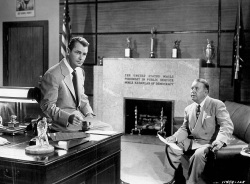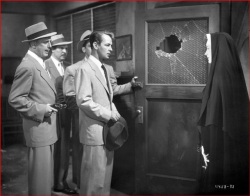




Appointment With Danger (1951)
| Production Company: | Paramount |
| Director: | Lewis Allen |
| Cast: | Alan Ladd (Al Goddard) |
| Phyllis Calvert (Sister Augustine) | |
| Paul Stewart (Earl Boettiger) | |
| Jan Sterling (Dodie) | |
| Jack Webb (Joe Regas) | |
| Stacy Harris (Paul Ferrar) | |
| Henry "Harry" Morgan (George Soderquist) | |
| David Wolfe (David Goodman) | |
| Dan Riss (Maury Ahearn) | |
| Harry Antrim (Postmaster Taylor) | |
| Geraldine Wall (Mother Ambrose) | |
| George J. Lewis (Leo Cronin) | |
| Paul Lees (Gene Gunner) |
 Another of those films completed and then held nearly two years for release, Appointment
with Danger was above-average Ladd fare, fast moving and full of action. The taut,
wel-plotted script dealt with the little-known workings of the Postal Inspection
Service. On the side of the law (as was to be his habit in the fifties), Ladd plays
a tight- lipped, relentless postal inspector assigned to investigate the murder
of another officer. The twist here comes in the form of a nun-the only witness to
the killing.
Another of those films completed and then held nearly two years for release, Appointment
with Danger was above-average Ladd fare, fast moving and full of action. The taut,
wel-plotted script dealt with the little-known workings of the Postal Inspection
Service. On the side of the law (as was to be his habit in the fifties), Ladd plays
a tight- lipped, relentless postal inspector assigned to investigate the murder
of another officer. The twist here comes in the form of a nun-the only witness to
the killing.
Sent to Gary, Indiana, where the murder was committed, Ladd must first find the nun and get her to identify one of the killers from a mug book. Then he must infiltrate the gang, who, it turn out, killed the other officer because he learned of their plans to rob a big mail shipment of money. Much suspense is generated by Ladd's attempt to convince the gang that he is a postal employee gone corrupt, and he walks a very thin line, coming harrowingly close to discovery.
The gang's resident psycho, Regas, takes an instant dislike to Goddard, and the spite between them threatens to explode into violence at any moment.
Earl, the gang's leader, warns Regas, "Somewhere in your blood there's a crazy bug. Get a cure or you'll get us all killed." Which proves prophetic.
A more interesting member of the gang is Dodie, Earl's girlfriend. With a wry insouciance, Sterling delivers the standard bad-girl line impressively, making her disregard for loyalty perfectly plausible. Ladd's encounters with these hardboiled types were usually tempered with a strong dash of sexual insinuation, and this film offers no exception.
Goddard cultivates Dodie, hoping to learn more of the gang's plans, but she has little real interest in what goes on. She invites him to her room to listen to her collection of bebop records and surprises him by becoming completely absorbed in the music and in no mood to discuss Earl's business. Finally she puts her favourite record on the turntable and moves to stand close to Goddard.
"So that's your 'Slow Bus to Memphis,'" he says in his silkiest voice.
"Yeah, she pouts, her look warm as the music pours out seductively "Can I give you a lift?"
"You already have," he purrs, taking her in his arms to dance. Pretty steamy stuff for 1951.
This dalliance with the gang's moll is not taken much further, perhaps because it runs counter to the relationship being developed between Ladd and the nun, Calvert. The killer the nun identified turns up dead. Joe Regas, the other killer, is obsessed with finding the nun and he nearly fouls up the robbery plan in his zeal to get her. When the robbery is accomplished, with mishaps, the gang meets at the shack and Regas walks in with the nun. In her surprise at seeing Goddard, she inadvertently gives him away, and a gun battle ensues. Police and postal officers close in and save the day.
The problem here is that the scriptwriters want to tell us about Ladd's character, rather than show us. He seems entirely manufactured, with little past implied and no future indicated, one of those characters who exist only for the running time of the film. "You need to try a little love," one of the characters says to Goddard, "but you don't even know what love is."
Goddard deadpans, "Sure I do. It's what happens between a man and a .45 that doesn't jam." Still, when Ladd read such lines, they work a lot better than they should.
The acting is generally good to excellent, with Paul Stewart a standout as the two- faced hotel manager, gracious to his guests, hard-nosed to his gang. Jack Webb's flat- voiced psycho gives real chills. And Harry Morgan, as the stammering, stupid little henchman who gets it from his friends, is plausibly pathetic.
The violence-crammed climax is riveting and well-staged, with bullets flying and bodies dropping everywhere-and once more a Ladd film came under fire to its unrelenting violence.
Low Key and perhaps not really memorable, Appointment with Danger was, nevertheless, a good, authentic thriller and one of Ladd's better performances. Regardless of the way the Goddard character was programmed by the script, Ladd put real life into him, making you care what happens to him-essential to any suspense movie. But he had this sort of thing down to second nature by this time, and little critical attention was paid to the film. It could not compare to Ladd's earlier successes.
The Films of Alan Ladd by Marilyn Henry and Ron DeSourdis
Alan Ladd was born in Hot Springs, Arkansas, on September 3, 1913, and his start in life was humble in the extreme. His mother had immigrated from England at the age of nineteen. His father, Alan Ladd, Sr., was an accountant who traveled a great deal and Alan could remember little about him except that he died when Alan was four.
At the age of five, Alan and a playmate were playing with matches one day and set fire to the apartment where he lived with his mother. Alan was unhurt, but all their belongings were destroyed. Ina took what money she had left and moved with her son to Oklahoma City.
There was never much money, and Alan was already undernourished and undersized. He was miserable at school and related only to his mother. When Alan was eight, his mother married a house painter named Jim Beavers. Beavers decided to pack up his new family and set off for California, where he was sure he could find plenty of house-painting jobs. It took months in their old Ford to travel the distance. Later, Alan describes it as a journey straight out of The Grapes of Wrath with everything they owned tied onto the top, sides and back of the car. At night they pitched tents to sleep and sometimes they had to pause several days while Beavers worked for enough money to buy gas. Once they reached Pasadena, California they first lived in a tent, then a shack and shared a rented house until Beavers finally got a job in Hollywood painting movie sets at the studios.
Alan worked at many odd jobs since he was a kid. The only place he didn't work was at school-he didn't graduate until he was twenty-but in high school a whole new world opened up for him when he discovered athletics. He was an accomplished runner on the track team and eventually became the president of the swim team. By his junior year he was class president and his marks had noticeably improved. He won medals and ribbons for swim meets and then became Southern California Diving Champion and established a new record for the 50-yard interscholastic meet. By 1931, he had a top coach, Clyde Swenson, and was busy preparing for the 1932 Olympics with every hope of making the team. But without the money to travel with his swim team, Alan to stay behind and he spent his time working out with the football team. After a diving mishap, Coach Swenson let him go which was a heartbreak for Ladd who had come so close to the Olympics.
Alan discovered girls and girls discovered him. He joined the drama class and began to get a few parts in school productions. He had a fine voice and a poised manner on stage. The Depression was keeping the Beavers at the poverty level and there was no question of him going to college. He auditioned at studios and did many odd jobs to earn money.
Alan met and married Marjorie Jane Harrold, known as Midge, in October 1936. At this time, his stepfather died of a heart attack. Neither Midge nor Alan could afford to live together until the birth of their son, Alan Ladd, Jr. born on October 22, 1937. They had little chance to be a family together as Ina Beavers moved in with them, having no place to go and no income. It was an unhappy arrangement as Ina spent what money she could on liquor. That November, after a bitter quarrel, Ina killed herself by swallowing ant paste. Alan witnessed her agonizing death and never fully recovered from the shock.
Acting doors continued to slam in Alan's face with only a few small roles here and there. In early 1939, he met and signed with the talent agent, Sue Carol. Sue Carol, who changed her name from Evelyn Lederer, was born in Chicago and moved to California in 1927, acting in silent movies. When she first laid eyes on Alan, Sue, who was ten years older than Ladd, said, "He came into my office wearing a long white trench coat. His blond hair was bleached by the sun. He looked like a young Greek god, and he was unforgettable." Alan became emotionally and professional dependent on Sue and eventually he and Midge divorced in 1941. Ladd was Sue's fourth husband. She was instrumental in building his career and the rest is history.
Notes compiled by Caren Feldman